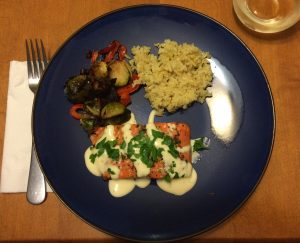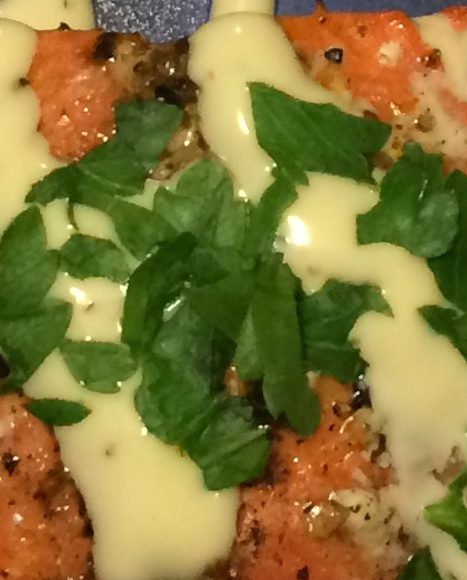If you haven’t discovered aïoli—a splendid blended sauce with egg yolk, garlic, lemon and olive oil—you’re missing a versatile condiment that can be herbed and spiced to enhance or even transform all kinds of dishes. For the sake of clarification, neither the sauce nor its name has any connection to Aeolus, the Greek god of wind. According to legend, Aeolus gave Odysseus a sack of wind to be used judiciously when sails needed filling. Odys, as he was known to his homies, guarded the bag closely. His crew suspected it was full of gold and opened it. The contents blew them away. Literally. The sack generated a hurricane that drove the Greek warrior-king off course and scattered or sank his fleet. It took Odysseus and his crew seven years to get home to Ithaca, a journey that gave us the word odyssey. In modern times that hazardous bag of wind would be called a Trump.
But I digress.
Aïoli hails from Provence and/or Catalonia. It is an emulsion of the French word for garlic, aïl (from the Latin aleatum) and the Latin olio, or oil. There is reason to believe that some versions of aïoli actually dates back at least 2000 years—maybe even back to Odys. The Romans had a garlic and oil sauce known as aleatum. Before refrigeration, high-speed transportation and other modern food-preserving practices, sauces like aïoli were used to mask the odors and flavors of putrefying meats, poultry and fish. Or they dressed up perishable proteins dried or cured into something unpalatable (lutefisk, anyone?) Condiments are now used to boost or complement the flavors of fresh or at least better-preserved ingredients. They can be meal savers on a boat, but they can also add an elegant touch to an already tasty appetizer or dish.
It needs to be said that aïoli is not just garlicked-up mayonnaise. Base ingredients are the same but aïoli adds another dimension. Garlic is the key difference, of course, but olive oil is essential in aïoli. For good measure, I often mince some good dark olives into the mix, as well. Niçoise olives are particularly good. Canola or some other bland vegetable oil suffices in mayo.
Another distinction is the process. Aïoli should start out by grinding garlic, olive oil and sea salt into a paste with a mortar and pestle. Then it gets whisked into egg yolk, lemon juice, mustard and more olive oil. A good fruity extra virgin olive oil is worth the extra expense for a dressing like this.
Now I have to confess that it had been awhile since I last made or used aïoli. It simply slipped off my culinary radar. But I was recently wracking my brain—and the internet—for something special to do with some sockeye salmon filets and I came across a jar of commercially made aïoli in my brother-in-laws’ refrigerator. I was skeptical about using it at first, but I gave it a taste and was pleasantly surprised. So I dressed the salmon with a lemon zest, garlic, salt and pepper rub and threw the filets on the grill. Once plated, I drizzled some of the bottled aïoli on the salmon and served it up with some brown rice flavored with French thyme and an exceptional mix of lemony grilled Brussels sprouts, red bell pepper and other veggies. Like the winds of Aeolus, it will blow you away.
I didn’t have a good Oregon Pinot noir, my favorite wine pairing with salmon, but I found that the unwooded, fruit-forward syrah Naked Grape was quite good with this meal. Naked Grape does a couple of box wines, including an unoaked Chardonnay, that are staples on Gaviidae. We shed the cardboard, of course, and keep the bladders in the plastic cereal canisters we modified to accommodate the spigots.
Aïoli
Ingredients:
- 2-3 cloves garlic, peeled, chopped fine
- 1-3 black olives, pitted and chopped fine
- 1 egg yolks
- ½ teaspoon sea salt
- 1 cup virgin olive oil
- 1/2 teaspoon water
- 1 teaspoon fresh lemon juice, or vinegar if a lemon is not available
- Zest of one lemon, if available
Directions:
First, make sure all your ingredients are at room temperature. Grind garlic, lemon zest and salt in the mortar bowl with the pestle. Take care to grind in one direction only. Grind in fresh or dried herbs or spices at this time. A food processor will work, but some elbow grease makes anything taste better. It’s a zen thing.
Place the paste into a medium sized bowl. If you are adding something creamy, like Dijon mustard, now is the time to whisk it in followed by the egg yolks. Slo-o-o-wly add half of the oil while whisking to emulsify the sauce. Add the water and lemon while continuing to stir or whisk, then slowly add the remaining oil. Continue to stir until the mix thickens to a consistency just short of mayonnaise.
If the sauce gets too thick, mix in warm water a teaspoon at a time. If the emulsion separates, whisk it into a single egg yolk at room temperature to re-emulsify.
The aïoli can also be flavored up by introducing small quantities of desired herbs or seasonings into the original paste—like the aforementioned mustard. In a pinch, go with store bought—but homemade aioli is so much better. Both require refrigeration.
Grilled Salmon
Ingredients:
- ½ pound salmon per person
- ½ tablespoon oil per filet
- Zest of one lemon
- 1-2 teaspoons fresh lemon juice per filet
- Thyme, basil or other favorite herbs spices to taste
- Sea salt and freshly ground pepper to taste
- 1/3 cup coarsely chopped Italian parsley
Directions:
With skin side down, drizzle oil and lemon over fish. Salt and pepper to taste, spread zest, herbs and spices over fish to taste. Let set at room temperature 10 to 15 minutes; cover and refrigerate if longer.
Fire up grill or oven. Place filets in a grill basket or sheet or on aluminum foil; set on preheated grill or in 375-400 degrees F oven. Cook for about 6 minutes per inch of thickness of the salmon.
Remove from grill/oven and cover; allow fish to rest for a few minutes. Drizzle filets with aioli, sprinkle with chopped parsley and serve.
Lemon Grilled Veggies
Ingredients:
- 6 Brussels sprouts per person
- Red bell pepper
- Zucchini and/or summer squash
- ½ medium yellow onion, sliced
- 2 cloves garlic, coarsely chopped
- Zest and juice of one lemon
- French thyme, fresh or dried, to taste
- ½ cup olive oil
- Salt and pepper to taste
Directions:
Wash the Brussels sprouts under cold water; shake in a colander to remove excess water. Trim ends and remove outside leaves; discard both. Depending on size, halve or quarter Brussel sprouts and place in medium to large bowl.
Rinse and cut bell pepper and zucchini/summer squash into bite size pieces. Discard stems and pepper ribs and seeds. Add chopped onion and garlic. Add oil and mix to coat all veggies. Add herbs and zest and toss well. Add half of the lemon juice, then salt and pepper to taste.
Place in a grilling basket or create a foil boat for the veggies. Put veggies on grill—away from open flame, if possible to avoid flame ups from the oil. Grill for about 15 minutes, shake or stir occasionally—until sprouts begin to brown. Remove to serving bowl; drizzle with remaining lemon juice. Serve hot.


